Page Outline
- Introduction
- Leaves
- Chloroplasts
- Photosynthesis Occurs in Two Phases
- Quiz: The Two Phases of Photosynthesis
1. Introduction: the evolutionary context for photosynthesis
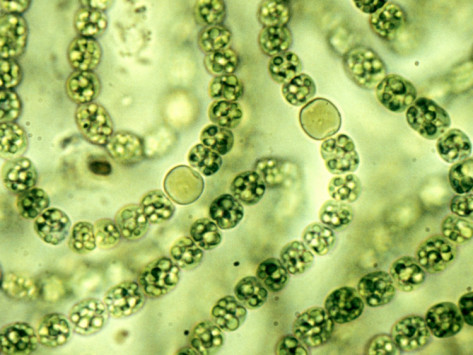
In the previous tutorial, we described photosynthesis as an energy-requiring oxidation-reduction reaction that occurs in the chloroplasts of plant cells. If we view photosynthesis in the context of Earth’s history, however, that last part is only partially correct. From about 3.5 billion years ago until the origin of eukaryotic cells about 1.5 billion years ago, photosynthesis was carried out by cyanobacteria. These photosynthetic bacteria are the organisms that put oxygen into our atmosphere. A modern example of cyanobacteria is shown on the left. Note that while the cells are combined into linear filaments, each cell is a completely autonomous individual: there’s no multicellularity in these prokaryotic organisms.
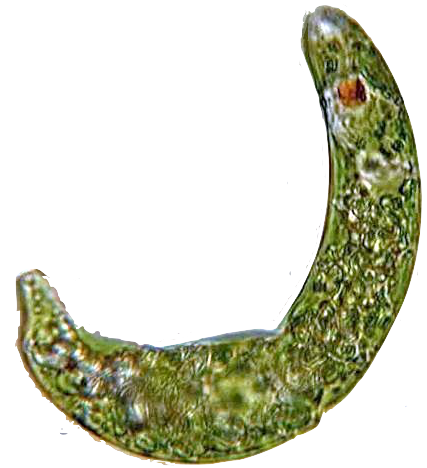
Through endosymbiosis, an ancient cyanobacterium took up residence inside another cell and evolved into the chloroplasts found today. You can find chloroplasts in unicellular protists (like the Euglena on the right, which you might have observed swimming in a drop of water under a microscope), algae (like seaweed), or plants. Let’s continue by putting chloroplasts into the context where terrestrial primates like us usually find them: in leaves.
2. Leaves
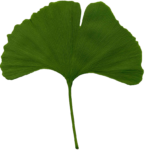
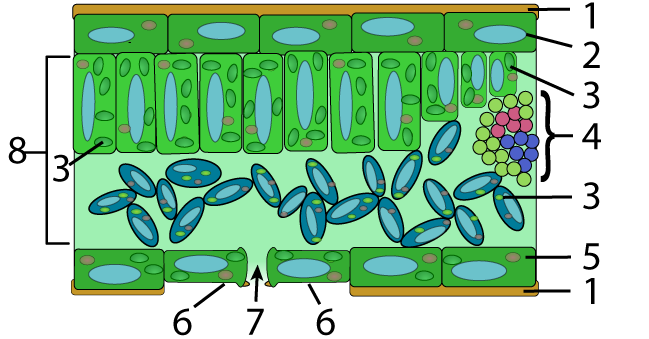
A leaf’s structure involves tradeoffs between maximizing surface area for absorption of light while minimizing water loss. To prevent water loss, a waxy cuticle (“1”) covers the upper (“2”) and lower (“5”) epidermis. The main function of the epidermis is protective, and much of the way that protection occurs is by secreting the waxy layer at “1.”
Within the leaf, most of the photosynthesis occurs in the middle, a section called the mesophyll (at “8”). The cells that make up the mesophyll are packed with chloroplasts (“3”).
Water comes into the leaf through bundles of vascular tissue (“4”), which we commonly refer to as veins. The veins also allow sugars to leave the leaf and move to other parts of the plant where they may, in a plant like a potato, get converted into polysaccharides like starch for long-term energy storage.
Carbon dioxide enters the plant through pores on the lower epidermis. These pores are called stomata (“7”), and they are formed by guard cells (“6”), which can change shape to adjust the size of the stomatal opening, even to the point of closing up altogether when the plant is experiencing a lack of water.
3. Chloroplast and the Two Phases of Photosynthesis: A Video Overview
4. Chloroplasts
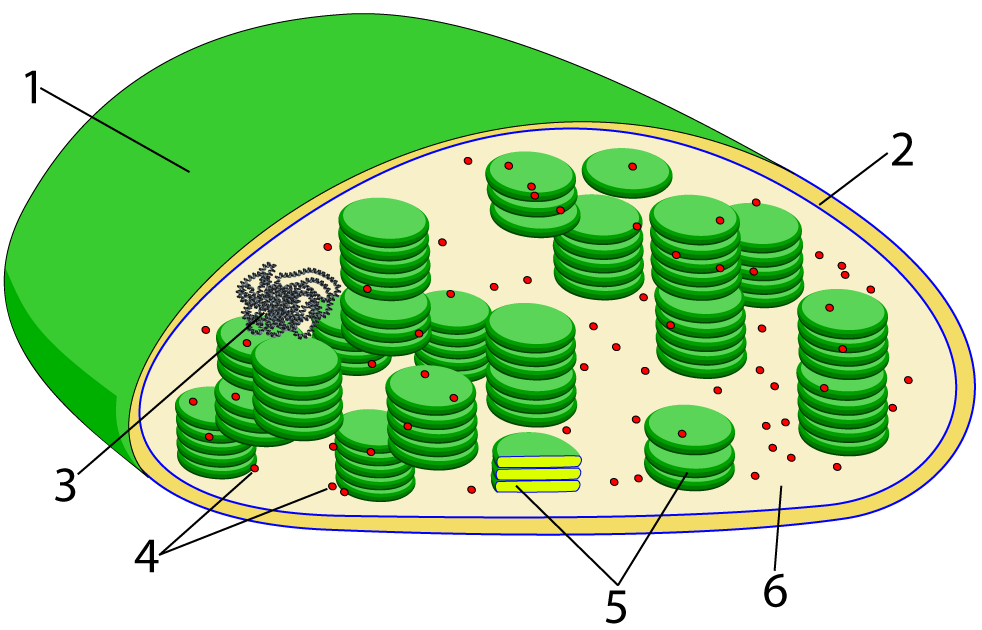 Looking at a chloroplast up close, you can see several vestiges of its bacterial origins. Like the cyanobacteria they evolved from, chloroplasts have a double membrane. The outer membrane is shown at “1.” The inner membrane is shown at “2.”
Looking at a chloroplast up close, you can see several vestiges of its bacterial origins. Like the cyanobacteria they evolved from, chloroplasts have a double membrane. The outer membrane is shown at “1.” The inner membrane is shown at “2.”
Chloroplasts, like mitochondria, have their own circular, bacteria-like chromosome (at “3”). Number 4 shows another vestige of the chloroplast’s once-independent existence. These are ribosomes, which have a bacterial (as opposed to a eukaryotic) molecular structure.
Chloroplasts are filled with membrane-bound sacs called thylakoids (“5”), which are organized into stacks (like a stack of pancakes). Outside of the thylakoid is a fluid called the stroma (“6”), which is analogous to the cytosol of a eukaryotic cell, or the matrix of a mitochondrion.
5. Within Chloroplasts, Photosynthesis Occurs in Two Phases
In the last tutorial, we looked at the overall equation for photosynthesis:
6CO2 + 6H2O + light energy –> C6H12O6 + 6O2
Within a chloroplast, photosynthesis occurs in two distinct phases, shown in roman numerals (“I” and “II”) in the diagrams below. Because of the complexity of the diagram, I’m providing you with both labeled and unlabeled versions.
Phase I (“I” below) makes up the light reactions. Driven by light energy (“1”), water gets oxidized: it’s split apart into high-energy electrons and protons (neither of which are shown below). These electrons and protons are used to reduce the oxidized electron carrier NADP+ (shown at “8”) into its reduced, high-energy form, NADPH ( at “5”). Energy harvested during the light reactions is also used to convert low-energy ADP and inorganic phosphate (“9” and “10,” respectively) into high-energy ATP (“4”). The waste product is oxygen, shown at “3”. All of this occurs in the thylakoid sacs, with the outputs of light reactions (NADPH and ATP) moving into the stroma to support the second phase of photosynthesis, known as the Calvin Cycle.
 |
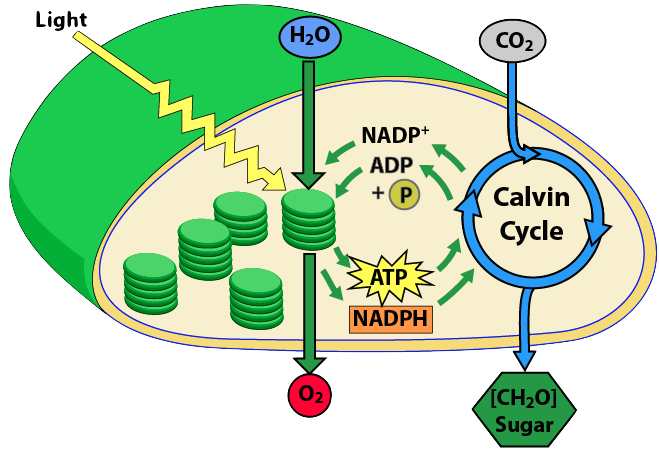 |
The Calvin Cycle (Phase II) makes carbohydrates (7). Named for UC Berkeley Biochemist Melvin Calvin, the Calvin cycle is also referred to as the light-independent reactions (or even as the dark reactions). The key external input is carbon dioxide (“6”). Using energy from ATP (“4”), and electrons and hydrogen from the reduced electron carrier NADPH (“5”), carbon dioxide is reduced to become the three-carbon sugar glyceraldehyde phosphate, or G3P (“7”), which can be converted into glucose (C6H12O6 ) or anything else the plant needs.
6. Quiz: Chloroplasts and the Two Phases of Photosynthesis
In the next tutorials, we’ll dive into the details of the light reactions and the Calvin cycle. But let’s consolidate what we’ve learned above through the following quiz.
[qwiz random = “true” qrecord_id=”sciencemusicvideosMeister1961-Chloroplasts and the Two Phases of PSN (2.0)”]
[h]The Two Phases of Photosynthesis
[i]
[q question_number=”1″ dataset_id=”SMV_PSN_Two_Phases_of_PSN|71727174b15e4″] The first organisms to perform photosynthesis were
[c]IGFsZ2FlLCBsaWtlIG1vZGVybiBzZWF3ZWVkcy4=[Qq]
[f]IE5vLiBBbGdhZSBhcmUgZXVrYXJ5b3Rlcy4gUHJva2FyeW90aWMgcGhvdG9zeW50aGVzaXplcnMgcHJlY2VkZWQgdGhlbSBieSB0d28gYmlsbGlvbiB5ZWFycy4gSW4gdGhlIGxpc3QgYWJvdmUsIHdoYXQgdGVybSBpbmRpY2F0ZXMgJiM4MjIwO3Byb2thcnlvdGljPyYjODIyMTs=[Qq]
[c]IGN5YW5vYm FjdGVyaWEu[Qq]
[f]IEV4Y2VsbGVudC4gQ3lhbm9iYWN0ZXJpYSwgYWxzbyBrbm93biBhcyBibHVlLWdyZWVuIGJhY3RlcmlhLCBhcmUgcGhvdG9zeW50aGVzaXppbmcgYmFjdGVyaWEsIGFuZCB0aGVpciBtb3JwaG9sb2dpY2FsbHkgc2ltaWxhciBhbmNlc3RvcnMgYXJlIHRob3VnaHQgdG8gYmUgdGhlIGZpcnN0IHBob3Rvc3ludGhlc2l6aW5nIG9yZ2FuaXNtcy4=[Qq]
[c]IHNpbXBsZSBwbGFudHMsIGxpa2UgbW9zc2VzIGFuZCBmZXJucy4=[Qq]
[f]IE5vLiBMYW5kIHBsYW50cywgZXZlbiBtb3NzZXMgYW5kIGZlcm5zLCBoYXZlIG9ubHkgYmVlbiBhcm91bmQgZm9yIGFib3V0IDQwMCBtaWxsaW9uIHllYXJzLiBUaGV5IHdlcmUgcHJlY2VkZWQgYnkgcGhvdG9zeW50aGV0aWMgcHJva2FyeW90ZXMgYnkgdGhyZWUgYmlsbGlvbiB5ZWFycy4gSW4gdGhlIGxpc3QgYWJvdmUsIHdoYXQgdGVybSBpbmRpY2F0ZXMgJiM4MjIwO3Byb2thcnlvdGljPyYjODIyMTs=
Cg==[Qq]
[q dataset_id=”SMV_PSN_Two_Phases_of_PSN|716da41c2b1e4″ question_number=”2″] In the diagram below, which number shows the cells that secrete the upper waxy layer that helps prevent water loss?
[textentry single_char=”true”]
[c]ID I=[Qq]
[f]IEV4Y2VsbGVudC4gVGhlIHVwcGVyIGVwaWRlcm1pcyBzZWNyZXRlcyB0aGUgd2F4eSBsYXllciB0aGF0IGhlbHBzIG1pbmltaXplIHdhdGVyIGxvc3Mu[Qq]
[c]IEVudGVyIHdvcmQ=[Qq]
[f]IE5vLCB0aGF0JiM4MjE3O3Mgbm90IGNvcnJlY3Qu[Qq]
[c]ICo=[Qq]
[f]IE5vLiBIZXJlJiM4MjE3O3MgYSBoaW50LiBUaGUgdXBwZXIgd2F4eSBsYXllciBpcyByaWdodCBuZXh0IHRvIHRoZSBjZWxscyB0aGF0IHNlY3JldGUgdGhhdCBsYXllci4gV2hpY2ggY2VsbHMgYXJlIHJpZ2h0IG5leHQgdG8gdGhlIHVwcGVyIHdheHkgbGF5ZXI/
Cg==[Qq]
[q dataset_id=”SMV_PSN_Two_Phases_of_PSN|71692145215e4″ question_number=”3″] In the diagram below, which number shows the organelle that’s performing photosynthesis?
[textentry single_char=”true”]
[c]ID M=[Qq]
[f]IFRlcnJpZmljLiAmIzgyMjA7MyYjODIyMTsgaW5kaWNhdGVzIHRoZSBjaGxvcm9wbGFzdHMsIHRoZSBvcmdhbmVsbGVzIHRoYXQgYXJlIHBlcmZvcm1pbmcgcGhvdG9zeW50aGVzaXMu[Qq]
[c]ICo=[Qq]
[f]IE5vLiBIZXJlJiM4MjE3O3MgYSBoaW50LiBZb3UmIzgyMTc7cmUgbG9va2luZyBmb3IgYW4gb3JnYW5lbGxlOiBzb21ldGhpbmcgaW5zaWRlIGEgY2VsbC4=
Cg==[Qq]
[q dataset_id=”SMV_PSN_Two_Phases_of_PSN|7164792d595e4″ question_number=”4″] Photosynthesis requires carbon dioxide as an input. Which part shows where carbon dioxide would enter the leaf?
[textentry single_char=”true”]
[c]ID c=[Qq]
[f]IE5pY2UgSm9iIS4gJiM4MjIwOzcmIzgyMjE7IGluZGljYXRlcyB0aGUgc3RvbWF0YSwgYW4gb3BlbmluZyBmb3JtZWQgYnkgZ3VhcmQgY2VsbHMgdGhyb3VnaCB3aGljaCBjYXJib24gZGlveGlkZSBjYW4gZGlmZnVzZSBpbnRvIHRoZSBsZWFmLg==[Qq]
[c]ICo=[Qq]
[f]IE5vLiBIZXJlJiM4MjE3O3MgYSBoaW50LiBXaGVyZSBpcyB0aGVyZSBhIGdhcCBpbiB0aGUgc3VyZmFjZSBvZiB0aGUgbGVhZiB0aHJvdWdoIHdoaWNoIGNhcmJvbiBkaW94aWRlIChhIGdhcykgY291bGQgZGlmZnVzZSBpbnRvIHRoZSBsZWFmPw==
Cg==[Qq]
[q dataset_id=”SMV_PSN_Two_Phases_of_PSN|715ff6564f9e4″ question_number=”5″] Photosynthesis requires water as an input. Which part shows where water would enter the leaf?
[textentry single_char=”true”]
[c]ID Q=[Qq]
[f]IEdvb2Qgd29yayEgJiM4MjIwOzQmIzgyMjE7IHNob3dzIGEgdmFzY3VsYXIgYnVuZGxlLCBhIHZlaW4gdGhyb3VnaCB3aGljaCB3YXRlciBhYnNvcmJlZCBmcm9tIHRoZSByb290cyBjYW4gZW50ZXIgdGhlIGxlYWYu[Qq]
[c]ICo=[Qq]
[f]IE5vLiBIZXJlJiM4MjE3O3MgYSBoaW50LiBXYXRlciBmbG93cyBpbnRvIHlvdXIgaG91c2UgdGhyb3VnaCBwaXBlcywgcmlnaHQ/IFdoaWNoIHN0cnVjdHVyZSBpbiB0aGUgbGVhZiBjb3VsZCBiZSBhIHRpbnksIG9yZ2FuaWMgcGlwZSB0aGF0IG1pZ2h0IGRlbGl2ZXIgd2F0ZXIgdG8gdGhlIHJlc3Qgb2YgdGhlIGxlYWY/
Cg==[Qq]
[q multiple_choice=”true” dataset_id=”SMV_PSN_Two_Phases_of_PSN|715b4e3e879e4″ question_number=”6″] The similarities between cyanobacteria and chloroplasts is evidence that chloroplasts arose through
[c]IG9zbW9zaXMu[Qq]
[f]IE5vLiBPc21vc2lzIGlzIHRoZSBkaWZmdXNpb24gb2Ygd2F0ZXImIzgyMzA7bm90IGEgbGlrZWx5IG1lY2hhbmlzbSBmb3IgdGhlIG9yaWdpbiBvZiBjaGxvcm9wbGFzdHMuIEhlcmUmIzgyMTc7cyBhIGhpbnQ6IGNobG9yb3BsYXN0cyBhcmUgaW5zaWRlIHBsYW50IGNlbGxzLiBXaGF0IHByZWZpeCBkbyB3ZSB1c2UgZm9yIHByb2Nlc3NlcyB3aGVyZSBzb21ldGhpbmcgZ29lcyA=aW50bw==IHNvbWV0aGluZyBlbHNlPw==[Qq]
[c]IGV4b2N5dG9zaXM=[Qq]
[f]IE5vLiBFeG9jeXRvc2lzIG1lYW5zICYjODIyMDtvdXQgb2YgdGhlIGNlbGwsJiM4MjIxOyBhbmQgaXQmIzgyMTc7cyB0aGUgbmFtZSBmb3IgdGhlIHByb2Nlc3MgZHVyaW5nIHdoaWNoIGNlbGxzIHVzZSB2ZXNpY2xlcyB0byBtb3ZlIG1hdGVyaWFscyBmcm9tIHRoZWlyIGN5dG9wbGFzbSB0byBvdXRzaWRlIHRoZWlyIG1lbWJyYW5lLiBIZXJlJiM4MjE3O3MgYSBoaW50OiBjaGxvcm9wbGFzdHMgYXJlIA==aW5zaWRlIHBsYW50IGNlbGxzLiBXaGF0IHByZWZpeCBkbyB3ZSB1c2UgZm9yIHByb2Nlc3NlcyB3aGVyZSBzb21ldGhpbmcgZ29lcyA=aW50bw==IHNvbWV0aGluZyBlbHNlPw==[Qq]
[c]IGVuZG9zeW 1iaW9zaXM=[Qq]
[f]IEV4Y2VsbGVudCEgQ2hsb3JvcGxhc3RzIGFyZSBtdXR1YWxpc3RpYyBzeW1iaW9udHMgbGl2aW5nIGluc2lkZSBwbGFudCAoYW5kIGFsZ2FsKSBjZWxscy4gVGhhdCBtYWtlcyB0aGVtIGVuZG9zeW1iaW9udHMuIFRoZSBwcm9jZXNzIHdoaWNoIGdhdmUgcmlzZSB0byB0aGlzIHBhcnRuZXJzaGlwIGlzIGNhbGxlZCAmIzgyMjA7ZW5kb3N5bWJpb3Npcy4mIzgyMjE7
Cg==[Qq]
[q dataset_id=”SMV_PSN_Two_Phases_of_PSN|7156cb677dde4″ question_number=”7″] The light reactions occur in which part?
[textentry single_char=”true”]
[c]NQ ==[Qq]
[f]QXdlc29tZSEgJiM4MjIwOzUmIzgyMjE7IHNob3dzIHRoZSB0aHlsYWtvaWQgc2Fjcywgd2hpY2ggaXMgd2hlcmUgdGhlIGxpZ2h0IHJlYWN0aW9ucyBvY2N1ci4=[Qq]
[c]ICo=[Qq]
[f]IE5vLiBIZXJlJiM4MjE3O3MgYSBoaW50LiBMaWtlIHRoZSBlbGVjdHJvbiB0cmFuc3BvcnQgY2hhaW4gb2Ygb3hpZGF0aXZlIHBob3NwaG9yeWxhdGlvbiAodGhlIGxhc3QgcGhhc2Ugb2YgY2VsbHVsYXIgcmVzcGlyYXRpb24pLCB0aGUgbGlnaHQgcmVhY3Rpb25zIHJlcXVpcmUgYSBsb3Qgb2YgbWVtYnJhbmUgc3VyZmFjZSBhcmVhIHRvIHByb2NlZWQuIFdoYXQgcGFydCBvZiB0aGUgY2hsb3JvcGxhc3QgbWlnaHQgcHJvdmlkZSB0aGlzIHN1cmZhY2UgYXJlYT8=
Cg==[Qq]
[q dataset_id=”SMV_PSN_Two_Phases_of_PSN|7152234fb5de4″ question_number=”8″] The Calvin Cycle occurs in which part of the chloroplast?
[textentry single_char=”true”]
[c]Ng ==[Qq]
[f]QXdlc29tZSEgJiM4MjIwOzYmIzgyMjE7IHNob3dzIHRoZSBzdHJvbWEsIHdoaWNoIGlzIHdoZXJlIHRoZSBDYWx2aW4gQ3ljbGUgb2NjdXJzLg==[Qq]
[c]ICo=[Qq]
[f]IE5vLiBIZXJlJiM4MjE3O3MgYSBoaW50LiBUaGUgQ2FsdmluIEN5Y2xlIG9jY3VycyBpbiB0aGUgZXF1aXZhbGVudCBvZiB0aGUgY3l0b3BsYXNtIG9mIHRoZSBjaGxvcm9wbGFzdC4gV2hpY2ggcGFydCBpcyBtb3N0IGFraW4gdG8gdGhlIGN5dG9wbGFzbT8=
Cg==[Qq]
[q dataset_id=”SMV_PSN_Two_Phases_of_PSN|714d7b37edde4″ question_number=”9″]One of the strongest pieces of evidence for the endosymbiotic origins of chloroplasts is the fact that they have DNA, which is shown at
[textentry single_char=”true”]
[c]Mw ==[Qq]
[f]QXdlc29tZSEgJiM4MjIwOzMmIzgyMjE7IHNob3dzIHRoZSBjaGxvcm9wbGFzdCYjODIxNztzIGNpcmN1bGFyLCBiYWN0ZXJpYS1saWtlIGNocm9tb3NvbWUuIFRoZSBleGlzdGVuY2Ugb2YgdGhpcyBjaHJvbW9zb21lIGlzIG9uZSBwaWVjZSBvZiBldmlkZW5jZSBmb3IgdGhlIGlkZWEgb2YgZW5kb3N5bWJpb3NpczogdGhhdCBjaGxvcm9wbGFzdHMgd2VyZSBvbmNlIGZyZWUtbGl2aW5nLCBpbmRlcGVuZGVudCBvcmdhbmlzbXMgdGhhdCBhdCBvbmUgcG9pbnQsIHRvb2sgdXAgcmVzaWRlbmNlIHdpdGhpbiBhbm90aGVyIGNlbGwu[Qq]
[c]ICo=[Qq]
[f]IE5vLiBIZXJlJiM4MjE3O3MgYSBoaW50LiBETkEgaXMgYSBsb25nIHNraW5ueSBtb2xlY3VsZS4gSW4gYmFjdGVyaWEsIHRoZSBETkHCoCBpcyBvcmdhbml6ZWQgaW50byBhIGJpZyBsb29wZWQgY2hyb21vc29tZS4gV2hpY2ggcGFydCBvZiB0aGUgZGlhZ3JhbSBpcyB0aGUgb25seSB0aGluZyB0aGF0IGNvdWxkIGZpdCB0aGF0IGRlc2NyaXB0aW9uPw==
Cg==[Qq]
[q dataset_id=”SMV_PSN_Two_Phases_of_PSN|7148f860e41e4″ question_number=”10″]If number 4 represents ATP, then which number would represent NADP+?
[textentry single_char=”true”]
[c]OA ==[Qq]
[f]QXdlc29tZSEgJiM4MjIwOzgmIzgyMjE7IGlzIE5BRFA=Kw==LCB3aGljaCBnZXRzIHJlZHVjZWQgdG8gTkFEUEg=[Qq]
[c]ICo=[Qq]
[f]IE5vLiBIZXJlJiM4MjE3O3MgYSBoaW50LiBJZiAmIzgyMjA7NCYjODIyMTsgaXMgQVRQLCB0aGVuIDkgYW5kIDEwIHdvdWxkIGJlIEFEUCBhbmQgUC4gQmVzaWRlcyB3YXRlciwgd2hhdCYjODIxNztzIHRoZSBvdGhlciBpbnB1dCBmb3IgdGhlIGxpZ2h0IHJlYWN0aW9ucz8=
Cg==[Qq]
[q dataset_id=”SMV_PSN_Two_Phases_of_PSN|71447589da5e4″ question_number=”11″]What letter or number represents the stroma?
[textentry single_char=”true”]
[c]Yg ==[Qq]
[f]QXdlc29tZSEgTGV0dGVyICYjODIyMDtiJiM4MjIxOyByZXByZXNlbnRzIHRoZSBzdHJvbWEu[Qq]
[c]ICo=[Qq]
[f]IE5vLiBIZXJlJiM4MjE3O3MgYSBoaW50LiBJZiBhIGNobG9yb3BsYXN0IGhhZCBjeXRvcGxhc20sIHRoaXMgd291bGQgYmUgaXQu
Cg==[Qq]
[q dataset_id=”SMV_PSN_Two_Phases_of_PSN|713fcd72125e4″ question_number=”12″]If 9 is ADP, then what letter or number represents the reduced molecule that’s an output of the light reactions and an input for the Calvin cycle?
[textentry single_char=”true”]
[c]NQ ==[Qq]
[f]QXdlc29tZSEgTGV0dGVyICYjODIyMDs1JiM4MjIxOyByZXByZXNlbnRzIE5BRFBILCBhIGNoZW1pY2FsbHkgcmVkdWNlZCBvdXRwdXQgb2YgdGhlIGxpZ2h0IHJlYWN0aW9ucyBhbmQgYW4gaW5wdXQgZm9yIHRoZSBDYWx2aW4gY3ljbGUu[Qq]
[c]ICo=[Qq]
[f]IE5vLiBIZXJlJiM4MjE3O3MgYSBoaW50LiBFbGVjdHJvbnMgYW5kIGh5ZHJvZ2VuIGZsb3cgZnJvbSB3YXRlciB0byB0aGlzIG1vbGVjdWxlLCB3aGljaCBoYXMgYW4gJiM4MjIwO0gmIzgyMjE7IHRoYXQgaXRzIG94aWRpemVkIGNvdW50ZXJwYXJ0IGxhY2tzLg==
Cg==[Qq]
[q dataset_id=”SMV_PSN_Two_Phases_of_PSN|713b255a4a5e4″ question_number=”13″]Which number or letter represents water?
[textentry single_char=”true”]
[c]Mg ==[Qq]
[f]VGVycmlmaWMhIExldHRlciAmIzgyMjA7MiYjODIyMTsgcmVwcmVzZW50cyB3YXRlciwgd2hpY2ggcHJvdmlkZXMgdGhlIGVsZWN0cm9ucyAoYW5kIGh5ZHJvZ2VucykgZm9yIHRoZSByZWR1Y3Rpb25zIHRoYXQgYXJlIGEga2V5IHBhcnQgb2YgcGhvdG9zeW50aGVzaXM=[Qq]
[c]ICo=[Qq]
[f]IE5vLiBIZXJlJiM4MjE3O3MgYSBoaW50LiBJdCYjODIxNztzIG9uZSBvZiB0aGUgaW5wdXRzIGZvciB0aGUgbGlnaHQgcmVhY3Rpb25zLiBBbHNvLCB0aGluayBhYm91dCBjb2xvciYjODIzMDs=
Cg==[Qq]
[q dataset_id=”SMV_PSN_Two_Phases_of_PSN|71367d42825e4″ question_number=”14″]Which number or letter represents oxygen?
[textentry single_char=”true”]
[c]Mw ==[Qq]
[f]VGVycmlmaWMhIExldHRlciAmIzgyMjA7MyYjODIyMTsgcmVwcmVzZW50cyBveHlnZW4sIHdoaWNoIGlzIHdoYXQmIzgyMTc7cyBsZWZ0IG9mIHdhdGVyICgmIzgyMjA7MiYjODIyMTspIGFmdGVyIGl0cyBlbGVjdHJvbnMgYW5kIHByb3RvbnMgYXJlIHN0cmlwcGVkIGF3YXku[Qq]
[c]ICo=[Qq]
[f]IE5vLiBIZXJlJiM4MjE3O3MgYSBoaW50LiBJdCYjODIxNztzIG9uZSBvZiB0aGUgb3V0cHV0cyBmb3IgdGhlIGxpZ2h0IHJlYWN0aW9ucyYjODIzMDthbmQgcGhvdG9zeW50aGVzaXMgYXMgYSB3aG9sZS4=
Cg==[Qq]
[q dataset_id=”SMV_PSN_Two_Phases_of_PSN|71314027c15e4″ question_number=”15″]Which number or letter represents carbon dioxide?
[textentry single_char=”true”]
[c]Ng ==[Qq]
[f]VGVycmlmaWMhIExldHRlciAmIzgyMjA7NiYjODIyMTsgcmVwcmVzZW50cyBjYXJib24gZGlveGlkZSwgd2hpY2ggZ2V0cyByZWR1Y2VkIHRvIGNhcmJvaHlkcmF0ZXMgaW4gdGhlIENhbHZpbiBjeWNsZS4=[Qq]
[c]ICo=[Qq]
[f]IE5vLiBIZXJlJiM4MjE3O3MgYSBoaW50LiBJdCYjODIxNztzIG9uZSBvZiB0aGUgaW5wdXRzIGZvciB0aGUgQ2FsdmluIGN5Y2xlJiM4MjMwO2FuZCBmb3IgcGhvdG9zeW50aGVzaXMgYXMgYSB3aG9sZSAobWVhbmluZyB0aGF0IGl0IGNvbWVzIGZyb20gb3V0c2lkZSB0aGUgY2hsb3JvcGxhc3QpLg==
Cg==[Qq]
[q dataset_id=”SMV_PSN_Two_Phases_of_PSN|712afe47cc9e4″ question_number=”16″]During photosynthesis, carbon dioxide gets reduced. What number or letter represents what carbon dioxide gets reduced into?
[textentry single_char=”true”]
[c]Nw ==[Qq]
[f]VGVycmlmaWMhIExldHRlciAmIzgyMjA7NyYjODIyMTsgcmVwcmVzZW50cyBjYXJib2h5ZHJhdGVzLiBUaGUgbW9zdCBpbW1lZGlhdGUgcHJvZHVjdCBpcyB0aGUgcmVkdWNlZCwgMyBjYXJib24gc3VnYXIgRzNQLCB3aGljaCBhIHBsYW50IGNlbGwgY2FuIG1ha2UgaW50byBnbHVjb3NlIG9yIGFueSBvdGhlciBtb2xlY3VsZSBpdCBuZWVkcy4=[Qq]
[c]ICo=[Qq]
[f]IE5vLiBIZXJlJiM4MjE3O3MgYSBoaW50LiBJdCYjODIxNztzIG9uZSBvZiB0aGUgb3V0cHV0cyBmb3IgdGhlIENhbHZpbiBjeWNsZSYjODIzMDthbmQgZm9yIHBob3Rvc3ludGhlc2lzIGFzIGEgd2hvbGUgKG1lYW5pbmcgdGhhdCBpdCBsZWF2ZXMgdGhlIGNobG9yb3BsYXN0KS4gQWxzbywgaXQmIzgyMTc7cyBzaGFwZWQgbGlrZSBhIG1vbm9zYWNjaGFyaWRlJiM4MjMwOw==[Qq]
[x]
[restart]
[/qwiz]
What’s next?
- Proceed to Topic 3.4 Part 3: Light, Pigments and Photosynthesis (the next tutorial in AP Bio Unit 3()
